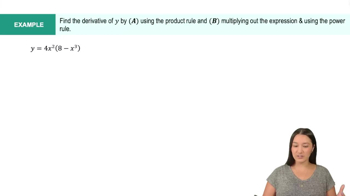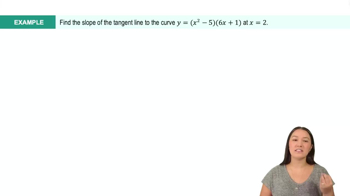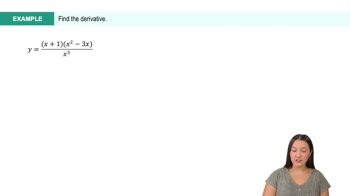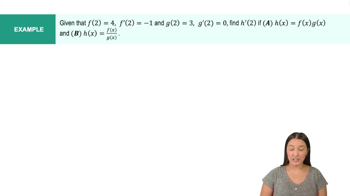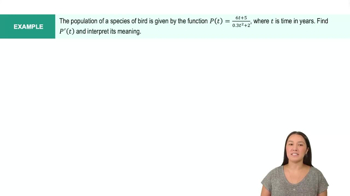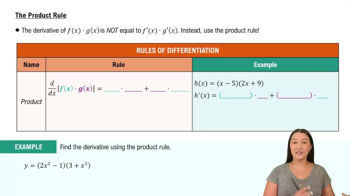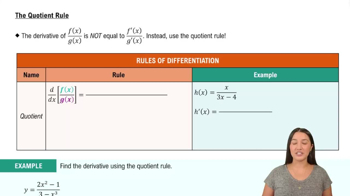Table of contents
- 0. Functions7h 52m
- Introduction to Functions16m
- Piecewise Functions10m
- Properties of Functions9m
- Common Functions1h 8m
- Transformations5m
- Combining Functions27m
- Exponent rules32m
- Exponential Functions28m
- Logarithmic Functions24m
- Properties of Logarithms34m
- Exponential & Logarithmic Equations35m
- Introduction to Trigonometric Functions38m
- Graphs of Trigonometric Functions44m
- Trigonometric Identities47m
- Inverse Trigonometric Functions48m
- 1. Limits and Continuity2h 2m
- 2. Intro to Derivatives1h 33m
- 3. Techniques of Differentiation3h 18m
- 4. Applications of Derivatives2h 38m
- 5. Graphical Applications of Derivatives6h 2m
- 6. Derivatives of Inverse, Exponential, & Logarithmic Functions2h 37m
- 7. Antiderivatives & Indefinite Integrals1h 26m
- 8. Definite Integrals4h 44m
- 9. Graphical Applications of Integrals2h 27m
- 10. Physics Applications of Integrals 2h 22m
3. Techniques of Differentiation
Product and Quotient Rules
Problem 62b
Textbook Question
Use a graphing utility to graph the curve and the tangent line on the same set of axes.
y = 2x2 / (3x - 1); a = 1
 Verified step by step guidance
Verified step by step guidance1
Step 1: Identify the function and the point of tangency. The function given is \( y = \frac{2x^2}{3x - 1} \) and the point of tangency is at \( x = 1 \).
Step 2: Find the derivative of the function to determine the slope of the tangent line. Use the quotient rule: if \( y = \frac{u}{v} \), then \( y' = \frac{u'v - uv'}{v^2} \). Here, \( u = 2x^2 \) and \( v = 3x - 1 \).
Step 3: Calculate \( u' \) and \( v' \). For \( u = 2x^2 \), \( u' = 4x \). For \( v = 3x - 1 \), \( v' = 3 \). Substitute these into the quotient rule formula to find \( y' \).
Step 4: Evaluate the derivative at \( x = 1 \) to find the slope of the tangent line. Substitute \( x = 1 \) into the derivative \( y' \) to get the slope \( m \).
Step 5: Use the point-slope form of a line to write the equation of the tangent line. The point-slope form is \( y - y_1 = m(x - x_1) \), where \( m \) is the slope found in Step 4, and \( (x_1, y_1) \) is the point \( (1, y(1)) \). Calculate \( y(1) \) using the original function.
 Verified video answer for a similar problem:
Verified video answer for a similar problem:This video solution was recommended by our tutors as helpful for the problem above
Video duration:
7mPlay a video:
Was this helpful?
Key Concepts
Here are the essential concepts you must grasp in order to answer the question correctly.
Graphing Functions
Graphing functions involves plotting points on a coordinate plane to visualize the relationship between variables. In this case, the function y = 2x² / (3x - 1) represents a rational function, which can exhibit various behaviors such as asymptotes and intercepts. Understanding how to graph this function is essential for analyzing its shape and identifying key features.
Recommended video:

Graph of Sine and Cosine Function
Tangent Lines
A tangent line to a curve at a given point represents the instantaneous rate of change of the function at that point. It is defined by the derivative of the function evaluated at that point. For the function y = 2x² / (3x - 1), finding the tangent line at x = 1 requires calculating the derivative and using the point-slope form of a line.
Recommended video:
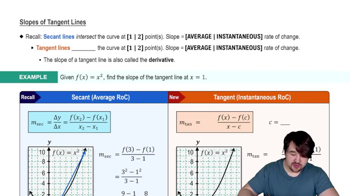
Slopes of Tangent Lines
Derivatives
The derivative of a function measures how the function's output changes as its input changes, providing a way to determine slopes of tangent lines. For the function y = 2x² / (3x - 1), applying the quotient rule will yield the derivative, which is crucial for finding the slope of the tangent line at the specified point. Understanding derivatives is fundamental in calculus for analyzing function behavior.
Recommended video:

Derivatives
Related Videos
Related Practice



